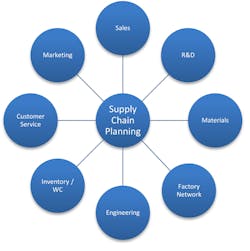Supply Chain Basics: Utilizing the Planning Process to Optimize Business Performance
It is not unusual to observe businesses of all kinds taking the view of their supply chain and manufacturing networks as a necessary evil. In most if not all cases, the externally facing functions—marketing and sales—get most of the attention. While finance commands internal respect, the supply chain, which is intricately woven into every aspect of the business, tends to be the utilitarian stepchild—meeting demand and controlling costs.
The biggest lever for optimizing business performance is to drive supply chain excellence by aligning it with business strategy. One of the elementary components for a high-performing supply chain is a robust set of planning processes. We see repeatedly in conversations with business partners, a yearning for improved sales and operations planning (S&OP) processes, demand planning programs, supply planning that optimizes factory performance, logistics performance, and the desire for better inventory and working capital management.
This article is not intended to be a tutorial, but as a quick look at key supply chain planning elements useful in making the point regarding the pivotal nature of superior planning processes. To the extent possible, I will attempt to remove as much jargon as possible from the discussion. All too often in formal supply chain presentations, there is the propensity to dive so deep into the details that the key points are lost. It is indeed a complex issue, but we are trying to not only make the supply chain point, but show how a company and its performance will benefit from the message.
Blocking and Tackling
Sports analogies abound, but if marketing and sales represent the backfield and receivers on a football team, the supply chain would be the offensive line, with planning at the center position. Essentially, the ball cannot be advanced down the field until it is snapped, and a business can’t perform at its highest level without a sound planning system.
While I am focusing here on the basics of supply chain planning processes, there are, of course other key planning elements in a business, not the least of which is the strategic plan and direction of the company. It goes without saying that all of the functions in an organization must accurately reflect the strategic objectives of the business. But with an eye on superior supply chain performance, another way to look at planning is as a hub, where each spoke connects to a function, all of which are reliant on a sound planning platform.
Key Supply Chain Planning Elements
Sales and Operations Planning
This is the key business planning element for marketing and sales leaders to interface with their internally-focused colleagues from finance and the supply chain. It is through this step, or series of steps, that the business can get input from all parties regarding product promotions, seasonal customer demand, innovation performance expectations, and a proper understanding of material requirements and capacity utilization at the factories.
In essence, this planning step puts the entire business on the same page regarding the coordination of supply assets and capabilities in order to meet customer demand requirements for the tactical (60-90 day horizon) and longer term (12 to 24 months). This process, typically monthly, is supplemented by a more operational counterpart, the weekly operations process, which focuses on the same issues at the operational, or zero to 60-day level.
Potential pitfalls and problems can materialize when hidden agendas fail to unmask complications. For example, the sales group may elect to underestimate upcoming demand in an attempt to “overdeliver” their revenue expectations, or they may simply not understand market or customer conditions. Businesses will often view this ploy as a good problem, but the fact is that rush shipments, unplanned factory overtime, irritated customers and value-robbing waste inevitably cut into bottom line profits.
A well run S&OP process can also prevent the business from overselling its installed capacity to produce finished goods. By understanding both the demand and supply details of the business, it can better control both revenue and cost profiles.
Demand Planning
This is an area where we see more confusion and higher levels of inaccuracy than in any other. If there is a “magic bullet” to improve overall supply chain performance, this is it. Why? Because demand forecast accuracy equates to:
- Accuracy of inbound materials management;
- Accuracy in manufacturing network utilization;
- Accuracy of inventory management and working capital;
- Accuracy in customer order fulfillment;
which all leads to:
-
Better financial management, cost control and less organizational waste.
This is an area where working closely with customers and suppliers can provide the supply chain with the opportunity to drive incremental value to a company. Think about the knock-on effects of poor demand planning: - Supply management needs to generate ongoing contingency plans for the purchase and delivery of materials to their factory networks, resulting in waste of time, cash and sub-optimal MRP system performance;
- Incorrect product mix in the wrong region, resulting in wasteful inter-facility and customer delivery freight costs;
- Ultimately leading to inaccurate supply planning and excessive levels of safety stock—again more waste of inventory, warehouse space and cash in the form of working capital;
- And finally, but of utmost importance, customer satisfaction problems.
Supply Planning
Bringing together all of the downstream elements of supply chain performance is the supply plan. It is here that companies can generate the optimum performance from their manufacturing, transportation and inventory management systems. Given that the production network, whether an internal factory network or third-party manufacturers, is the source of conversion cost expenses, greater accuracy in the supply plan (driven of course by an accurate demand plan) invariably leads to fewer line changeovers, (with the associated reduced downtime), longer run sequences (and the associated lower waste), higher asset utilization rates, more accurate inventory quantities, and better on-time deliveries to customers. Oftentimes, accuracy in the overall planning process allows a company to reduce capital expenditures related to capacity requirements, since better utilization of installed capacity equates to a built in increase in system capacity.
The elimination of wasteful downtime, reduction of safety stock levels, coordination of material flow and inbound freight, knowledge of customer requirements, and the direction of marketing promotions all yield to a classic definition of lean operations and manufacturing. This reduction of waste in all its forms provides the foundation for better margins and higher profitability.
While not as sexy as product innovation, branding exercises, promotions, or packaging design, dedication to excellent planning systems helps to drive everything from purchasing efficiency to superior customer service. Powerful planning processes provide the essential elements for business success through material management, lean operations, waste reduction and working capital optimization.
Tony Verlezza is an associate partner at Equus Group LLC, a supply chain advisory services company based in New York, Sao Paulo, Lausanne and London and is a former supply chain executive for Unilever.

